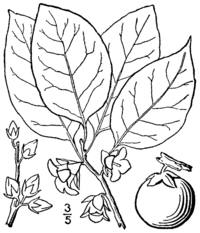
Seed dispersal of Diospyros virginiana in the past and the present: Evidence for a generalist evolutionary strategy
Sign Up to like & getrecommendations! Published in 2017 at "Ecology and Evolution"
DOI: 10.1002/ece3.3008
Abstract: Abstract Several North American trees are hypothesized to have lost their co‐evolved seed disperser during the late‐Pleistocene extinction and are therefore considered anachronistic. We tested this hypothesis for the American persimmon (Diospyros virginiana) by studying… read more here.
Keywords: seed; diospyros virginiana; persimmon; gut passage ... See more keywords

Cholesterol-lowering effect of astringent persimmon fruits (Diospyros kaki Thunb.) extracts
Sign Up to like & getrecommendations! Published in 2017 at "Food Science and Biotechnology"
DOI: 10.1007/s10068-017-0031-4
Abstract: This study aimed to investigate the effects of ethanol extract of astringent persimmon on antioxidant activity, cholesterol, 3-hydroxy-3-methylglutaryl (HMG)-CoA reductase activity, and mRNA expression of cholesterol metabolism-related genes in human hepatoma cell line (HepG2 cells).… read more here.
Keywords: astringent persimmon; lowering effect; persimmon; cholesterol lowering ... See more keywords

Three novel viruses detected from Japanese persimmon ‘Reigyoku’ associated with graft-transmissible stunt
Sign Up to like & getrecommendations! Published in 2020 at "European Journal of Plant Pathology"
DOI: 10.1007/s10658-020-02063-0
Abstract: Three novel viruses were detected from Japanese persimmon ‘Reigyoku’ (Diospyros kaki), which grows poorly when top-grafted onto some interstocks. The genomic characterization and the phylogenetic analysis of these viruses indicated that they are likely new… read more here.
Keywords: persimmon; japanese persimmon; novel viruses; viruses detected ... See more keywords

Evaluation of Persimmon (Diospyros kaki Thunb. cv. Rojo Brillante) Industrial Residue as a Source for Value Added Products
Sign Up to like & getrecommendations! Published in 2019 at "Waste and Biomass Valorization"
DOI: 10.1007/s12649-019-00621-0
Abstract: PurposeTo evaluate the potential of the industrial waste of Rojo Brillante persimmon as a source for value-added products. The antioxidant compounds present in persimmon industrial waste (peel and calyx) and the suitability of this bagasse… read more here.
Keywords: waste; value added; persimmon; added products ... See more keywords

Phenolic compositions and antioxidant properties of leaves of eight persimmon varieties harvested in different periods.
Sign Up to like & getrecommendations! Published in 2019 at "Food chemistry"
DOI: 10.1016/j.foodchem.2019.03.048
Abstract: The compositions and contents of antioxidant components and antioxidant attributes (scavenging DPPH radicals, TEAC, ferric reducing power and inhibiting Cu2+-induced human LDL oxidation) for the leaves of eight persimmon varieties harvested from Sep. to Nov.… read more here.
Keywords: leaves eight; persimmon; antioxidant properties; varieties harvested ... See more keywords

Polyphenol oxidase plays a critical role in melanin formation in the fruit skin of persimmon (Diospyros kaki cv. 'Heishi').
Sign Up to like & getrecommendations! Published in 2020 at "Food chemistry"
DOI: 10.1016/j.foodchem.2020.127253
Abstract: In this study, the melanin in persimmon and its formation were investigated. Melanin was found to be deposited on the cell walls of the upper epidermis and subepidermal cells in persimmon skin and the isolated… read more here.
Keywords: persimmon; melanin; skin; melanin formation ... See more keywords

DkPK Genes Promote Natural Deastringency in C-PCNA Persimmon by Up-regulating DkPDC and DkADH Expression
Sign Up to like & getrecommendations! Published in 2017 at "Frontiers in Plant Science"
DOI: 10.3389/fpls.2017.00149
Abstract: The astringency of Chinese pollination-constant non-astringent (C-PCNA) persimmon (Diospyros kaki Thunb.) can be naturally removed on the tree. This process is controlled by a single locus and is dominant against other types of persimmons; therefore,… read more here.
Keywords: pcna persimmon; persimmon; dkpk7 dkpk8; expression ... See more keywords

Effects of Different Chemicals on Sexual Regulation in Persimmon (Diospyros kaki Thunb.) Flowers
Sign Up to like & getrecommendations! Published in 2022 at "Frontiers in Plant Science"
DOI: 10.3389/fpls.2022.876086
Abstract: Research on crop sexuality is important for establishing systems for germplasm innovation and cultivating improved varieties. In this study, androecious persimmon trees were treated with various concentrations of ethrel (100, 500, and 1,000 mg/L) and… read more here.
Keywords: different chemicals; development; androecious persimmon; persimmon ... See more keywords

DkmiR397 Regulates Proanthocyanidin Biosynthesis via Negative Modulating DkLAC2 in Chinese PCNA Persimmon
Sign Up to like & getrecommendations! Published in 2022 at "International Journal of Molecular Sciences"
DOI: 10.3390/ijms23063200
Abstract: Persimmon fruits accumulate a large amount of proanthocyanidins (PAs), which makes an astringent sensation. Proanthocyanidins (PAs) are the polymers of flavan-3-ols stored in plant vacuoles under laccase activation. A laccase gene, DkLAC2, is putatively involved… read more here.
Keywords: biosynthesis; dkmir397 persimmon; dklac2; expression ... See more keywords